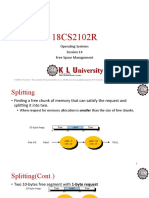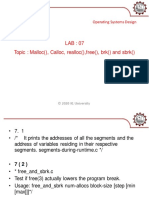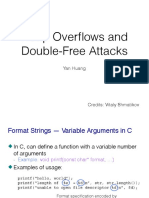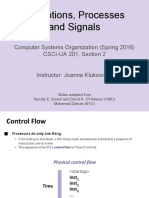Dynamic Memory Allocation
Computer Systems Organization (Spring 2016)
CSCI-UA 201, Section 2
Instructor: Joanna Klukowska
Slides adapted from
Randal E. Bryant and David R. OHallaron (CMU)
Mohamed Zahran (NYU)
�Basic Concepts
Programmers use dynamic
memory allocators (such as
malloc) to acquire VM at run
time.
For data structures whose size is
only known at runtime.
Dynamic memory allocators
manage an area of process
virtual memory known as the
heap.
malloc
brk
bss
.data
.text
3
� Allocator maintains heap as collection of variable sized
blocks, which are either allocated or free
Types of allocators
Explicit allocator: application allocates and frees space
E.g., malloc and free in C
Implicit allocator: application allocates, but does not free space
E.g. garbage collection in Java, ML, and Lisp
�malloc
#include <stdlib.h>
void *malloc(size_t size)
Successful:
Returns a pointer to a memory block of at least size bytes
aligned to an 8-byte (x86) or 16-byte (x86-64) boundary
If size == 0, returns NULL
Unsuccessful: returns NULL (0) and sets errno
void free(void *p)
Returns the block pointed at by p to pool of available memory
p must come from a previous call to malloc or realloc
Other functions
calloc: Version of malloc that initializes allocated block to zero.
realloc: Changes the size of a previously allocated block.
sbrk: Used internally by allocators to grow or shrink the heap
5
�malloc
#include <stdio.h>
#include <stdlib.h>
void foo(int n) {
int i, *p;
/* Allocate a block of n ints */
p = (int *) malloc(n * sizeof(int));
if (p == NULL) {
perror("malloc");
exit(0);
}
/* Initialize allocated block */
for (i=0; i<n; i++)
p[i] = i;
/* Return allocated block to the heap */
free(p);
}
6
Memory is word addressed.
Words are int-sized.
�p1 = malloc(4)
p2 = malloc(5)
p3 = malloc(6)
free(p2)
p4 = malloc(2)
� Applications
Can issue arbitrary sequence of malloc and free requests
free request must be to a mallocd block
Allocators
Cant control number or size of allocated blocks
Must respond immediately to malloc requests
i.e., cant reorder or buffer requests
Must allocate blocks from free memory
i.e., can only place allocated blocks in free memory
Must align blocks so they satisfy all alignment requirements
8-byte (x86) or 16-byte (x86-64) alignment on Linux boxes
Can manipulate and modify only free memory
Cant move the allocated blocks once they are mallocd
i.e., compaction is not allowed
9
�malloc
free
malloc
free
10
�malloc
free
malloc(p)
sbrk
11
12
For a given block, internal fragmentation occurs if payload is smaller than
block size
Caused by
Overhead of maintaining heap data structures
Padding for alignment purposes
Explicit policy decisions
(e.g., to return a big block to satisfy a small request)
Depends only on the pattern of previous requests
Thus, easy to measure
13
p1 = malloc(4)
p2 = malloc(5)
p3 = malloc(6)
free(p2)
p4 = malloc(6)
14
15
p0
p0 = malloc(4)
free(p0)
16
Method 1: Implicit list using lengthlinks all blocks
Method 2: Explicit list among the free blocks using pointers
Method 3: Segregated free list
Different free lists for different size classes
Method 4: Blocks sorted by size
Can use a balanced binary tree (e.g. Red-Black tree) with pointers within each free block, and
the length used as a key
17
�Implicit Free List
18
For each block we need both size and allocation status
Could store this information in two words: wasteful!
Standard trick
If blocks are aligned, some low-order address bits are always 0
Instead of storing an always-0 bit, use it as a allocated/free flag
When reading size word, must mask out this bit
19
�*Assume 8-byte (2 word) align boundary.
20
First fit:
Search list from beginning, choose first free block that fits
Can take linear time in total number of blocks (allocated and free)
In practice it can cause splinters at beginning of list
Next fit:
Like first fit, but search list starting where previous search finished
Should often be faster than first fit: avoids re-scanning unhelpful blocks
Some research suggests that fragmentation is worse
Best fit:
Search the list, choose the best free block: fits, with fewest bytes left over
Keeps fragments smallusually improves memory utilization
Will typically run slower than first fit
21
addblock(p, 4)
22
free(p)
malloc(5)
There is enough free space, but the allocator wont be able to find it
(since it sees a block of 4 and block of 2, not a block of 5).
23
free(p)
24
25
�26
�27
�What do we do, if the next block is free as well?
Not possible if we always coalesce.
28
�29
�30
Placement policy:
First-fit, next-fit, best-fit, etc.
Trades off lower throughput for less fragmentation
Interesting observation: segregated free lists (next lecture) approximate a best fit placement
policy without having to search entire free list
Splitting policy:
When do we go ahead and split free blocks?
How much internal fragmentation are we willing to tolerate?
Coalescing policy:
Immediate coalescing: coalesce each time free is called
Deferred coalescing: try to improve performance of free by deferring coalescing until
needed. Examples:
Coalesce as you scan the free list for malloc
Coalesce when the amount of external fragmentation reaches some threshold
31
Implementation: very simple
Allocate cost:
linear time worst case
Free cost:
constant time worst case
even with coalescing
Memory usage:
will depend on placement policy
First-fit, next-fit or best-fit
Not used in practice for malloc/free because of linear-time allocation
used in many special purpose applications
However, the concepts of splitting and boundary tag coalescing are general
to all allocators
32
�Explicit Free List
33
Method 1: Implicit list using lengthlinks all blocks
Method 2: Explicit list among the free blocks using pointers
Method 3: Segregated free list
Different free lists for different size classes
Method 4: Blocks sorted by size
Can use a balanced binary tree (e.g. Red-Black tree) with pointers within each free block, and
the length used as a key
34
35
36
�= malloc()
37
38
�free( )
39
�free( )
40
�free( )
41
�free( )
42
43
Method 1: Implicit list using lengthlinks all blocks
Method 2: Explicit list among the free blocks using pointers
5
Method 3: Segregated free list
Different free lists for different size classes
Method 4: Blocks sorted by size
Can use a balanced tree (e.g. Red-Black tree) with pointers within each free block, and the
length used as a key
44
�Segregated Free List
45
46
sbrk()
47
48
�Garbage Collection
49
void foo() {
int *p = malloc(128);
return; /* p block is now garbage */
}
50
int
51
52
�Memory Related Bugs
53
54
�int *p
int *p[13]
int *(p[13])
int **p
int (*p)[13]
int *f()
int (*f)()
int (*(*f())[13])()
int (*(*x[3])())[5]
55
�scanf
int val;
...
scanf("%d", val);
56
�/* return y = Ax */
int *matvec(int **A, int *x) {
int *y = malloc(N*sizeof(int));
int i, j;
for (i=0; i<N; i++)
for (j=0; j<N; j++)
y[i] += A[i][j]*x[j];
return y;
}
57
�int **p;
p = malloc(N*sizeof(int));
for (i=0; i<N; i++) {
p[i] = malloc(M*sizeof(int));
}
58
�int **p;
p = malloc(N*sizeof(int *));
for (i=0; i<=N; i++) {
p[i] = malloc(M*sizeof(int));
}
59
�char s[8];
int i;
gets(s);
/* reads 123456789 from stdin */
60
�int *search(int *p, int val) {
while (*p && *p != val)
p += sizeof(int);
return p;
}
61
�int * heap_delete(int **binheap, int *size) {
int *packet;
packet = binheap[0];
binheap[0] = binheap[*size - 1];
*size--;
heapify(binheap, *size, 0);
return(packet);
}
62
�int *foo () {
int val;
return &val;
}
63
�x = malloc(N*sizeof(int));
<manipulate x>
free(x);
y = malloc(M*sizeof(int));
<manipulate y>
free(x);
64
�x = malloc(N*sizeof(int));
<manipulate x>
free(x);
...
y = malloc( M*sizeof(int) );
for (i=0; i < M; i++)
y[i] = x[i]++;
65
�foo() {
int *x = malloc(N*sizeof(int));
...
return;
}
66
�struct list {
int val;
struct list *next;
};
foo() {
struct list *head = malloc(sizeof(struct list));
head->val = 0;
head->next = NULL;
<create and manipulate the rest of the list>
...
free(head);
return;
}
67
�gdb
valgrind
setenv MALLOC_CHECK_ 3 (see the manual page for mallopt)
68



































































































